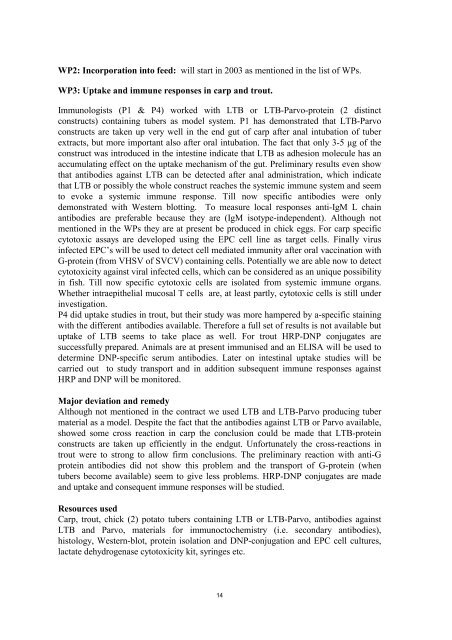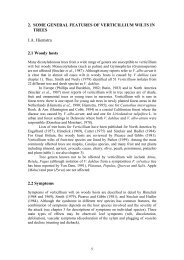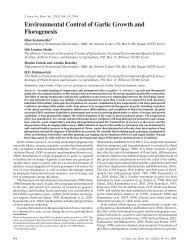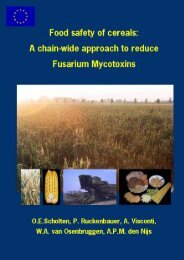CONFIDENTIAL REPORT - Plant Research International
CONFIDENTIAL REPORT - Plant Research International
CONFIDENTIAL REPORT - Plant Research International
- No tags were found...
You also want an ePaper? Increase the reach of your titles
YUMPU automatically turns print PDFs into web optimized ePapers that Google loves.
WP2: Incorporation into feed: will start in 2003 as mentioned in the list of WPs.WP3: Uptake and immune responses in carp and trout.Immunologists (P1 & P4) worked with LTB or LTB-Parvo-protein (2 distinctconstructs) containing tubers as model system. P1 has demonstrated that LTB-Parvoconstructs are taken up very well in the end gut of carp after anal intubation of tuberextracts, but more important also after oral intubation. The fact that only 3-5 µg of theconstruct was introduced in the intestine indicate that LTB as adhesion molecule has anaccumulating effect on the uptake mechanism of the gut. Preliminary results even showthat antibodies against LTB can be detected after anal administration, which indicatethat LTB or possibly the whole construct reaches the systemic immune system and seemto evoke a systemic immune response. Till now specific antibodies were onlydemonstrated with Western blotting. To measure local responses anti-IgM L chainantibodies are preferable because they are (IgM isotype-independent). Although notmentioned in the WPs they are at present be produced in chick eggs. For carp specificcytotoxic assays are developed using the EPC cell line as target cells. Finally virusinfected EPC’s will be used to detect cell mediated immunity after oral vaccination withG-protein (from VHSV of SVCV) containing cells. Potentially we are able now to detectcytotoxicity against viral infected cells, which can be considered as an unique possibilityin fish. Till now specific cytotoxic cells are isolated from systemic immune organs.Whether intraepithelial mucosal T cells are, at least partly, cytotoxic cells is still underinvestigation.P4 did uptake studies in trout, but their study was more hampered by a-specific stainingwith the different antibodies available. Therefore a full set of results is not available butuptake of LTB seems to take place as well. For trout HRP-DNP conjugates aresuccessfully prepared. Animals are at present immunised and an ELISA will be used todetermine DNP-specific serum antibodies. Later on intestinal uptake studies will becarried out to study transport and in addition subsequent immune responses againstHRP and DNP will be monitored.Major deviation and remedyAlthough not mentioned in the contract we used LTB and LTB-Parvo producing tubermaterial as a model. Despite the fact that the antibodies against LTB or Parvo available,showed some cross reaction in carp the conclusion could be made that LTB-proteinconstructs are taken up efficiently in the endgut. Unfortunately the cross-reactions introut were to strong to allow firm conclusions. The preliminary reaction with anti-Gprotein antibodies did not show this problem and the transport of G-protein (whentubers become available) seem to give less problems. HRP-DNP conjugates are madeand uptake and consequent immune responses will be studied.Resources usedCarp, trout, chick (2) potato tubers containing LTB or LTB-Parvo, antibodies againstLTB and Parvo, materials for immunoctochemistry (i.e. secondary antibodies),histology, Western-blot, protein isolation and DNP-conjugation and EPC cell cultures,lactate dehydrogenase cytotoxicity kit, syringes etc.14







